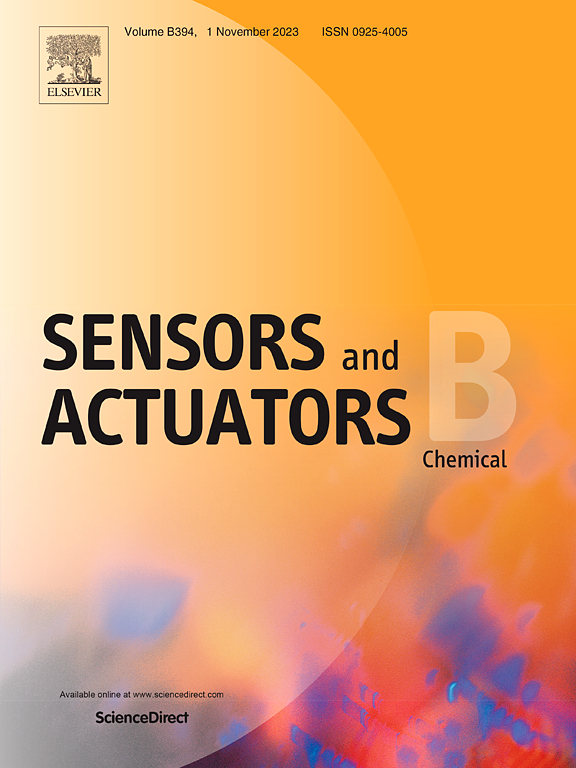蛋白质约束与聚集诱导发射增强策略协同检测四环素
IF 3.7
1区 化学
Q1 CHEMISTRY, ANALYTICAL
引用次数: 0
摘要
空间约束策略为解决溶液中聚集致发射(AIE)材料的发光猝灭问题提供了一种新的方法。然而,传统的合成载体存在批次间可变性和生物相容性差的问题。摘要利用卵清蛋白(OVA)的天然纳米空腔作为生物相容性载体,通过分子自组装,研制了一种具有核壳结构的聚集诱导电化学发光(AIECL)探针。该策略创新性地将蛋白质约束与AIECL相结合,有效抑制了四(4-氨基苯基)乙烯(ETTA)在溶液中的发光猝灭,显著提高了电化学发光(ECL)性能。此外,OVA约束具有多重优势:OVA通过共价键和疏水相互作用提供双重约束,增强了OVA/ETTA的稳定性和ECL强度;OVA提高了ETTA的水溶性,同时减轻了其细胞毒性;温和的合成条件无需高温或高压,显著降低了能耗;OVA为适体(Apt)的结合提供了活性位点。共反应启动子的引入进一步增强了该传感器的ECL响应,实现了在0.1 pM~1 μM范围内对四环素的精确检测,检测限为42.6 fM。该策略不仅拓展了食品蛋白在AIECL传感中的应用,而且符合绿色化学原理,为开发环境友好、低能耗的ECL分析平台提供了新的思路。本文章由计算机程序翻译,如有差异,请以英文原文为准。
Protein-confinement synergizes with aggregation-induced-emission enhancement strategy for tetracycline detection
Spatial confinement strategy presents a novel approach to addressing the luminescence quenching of aggregation-induced-emission (AIE) materials in solution. However, traditional synthetic carriers suffer from batch-to-batch variability and poor biocompatibility. A novel aggregation-induced-electrochemiluminescence (AIECL) probe with core-shell structure was developed based on natural nanocavities of ovalbumin (OVA) as a biocompatible carrier through molecular self-assembly. This strategy innovatively integrates protein confinement with AIECL, effectively suppressing the luminescence quenching of tetrakis(4-aminophenyl)ethene (ETTA) in solution and significantly enhancing electrochemiluminescence (ECL) performance. Furthermore, OVA confinement offered multiple advantages: OVA provided dual-confinement through covalent bonds and hydrophobic interactions that enhanced the stability and ECL intensity of OVA/ETTA; OVA improved the aqueous solubility of ETTA while mitigating its cytotoxicity; the mild synthesis conditions without high temperature or pressure significantly reduced energy consumption; OVA provided active sites for aptamer (Apt) conjugation. The introduction of the coreaction promoter further enhanced the ECL responses of the aptasensor, enabling precise detection of tetracycline in the range of 0.1 pM∼1 μM with a detection limit of 42.6 fM. This strategy not only expands the application of food proteins in AIECL sensing but also adheres to Green Chemistry principles and provides new insights into the development of an environmentally-friendly, and low-energy-consumption ECL analysis platform.
求助全文
通过发布文献求助,成功后即可免费获取论文全文。
去求助
来源期刊

Sensors and Actuators B: Chemical
工程技术-电化学
CiteScore
14.60
自引率
11.90%
发文量
1776
审稿时长
3.2 months
期刊介绍:
Sensors & Actuators, B: Chemical is an international journal focused on the research and development of chemical transducers. It covers chemical sensors and biosensors, chemical actuators, and analytical microsystems. The journal is interdisciplinary, aiming to publish original works showcasing substantial advancements beyond the current state of the art in these fields, with practical applicability to solving meaningful analytical problems. Review articles are accepted by invitation from an Editor of the journal.
 求助内容:
求助内容: 应助结果提醒方式:
应助结果提醒方式:


